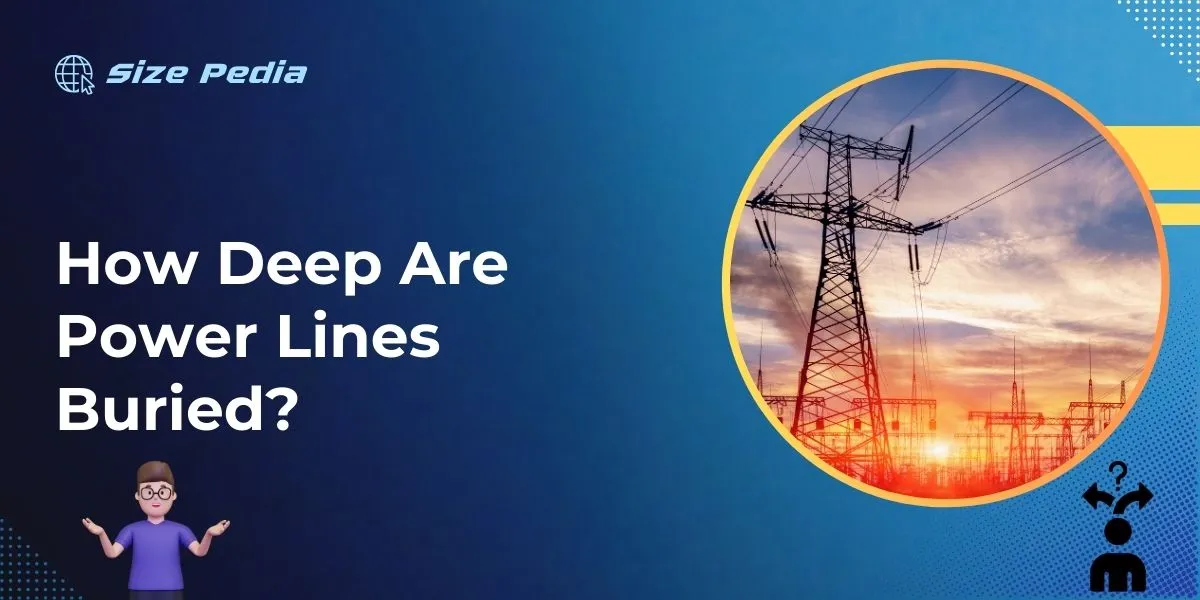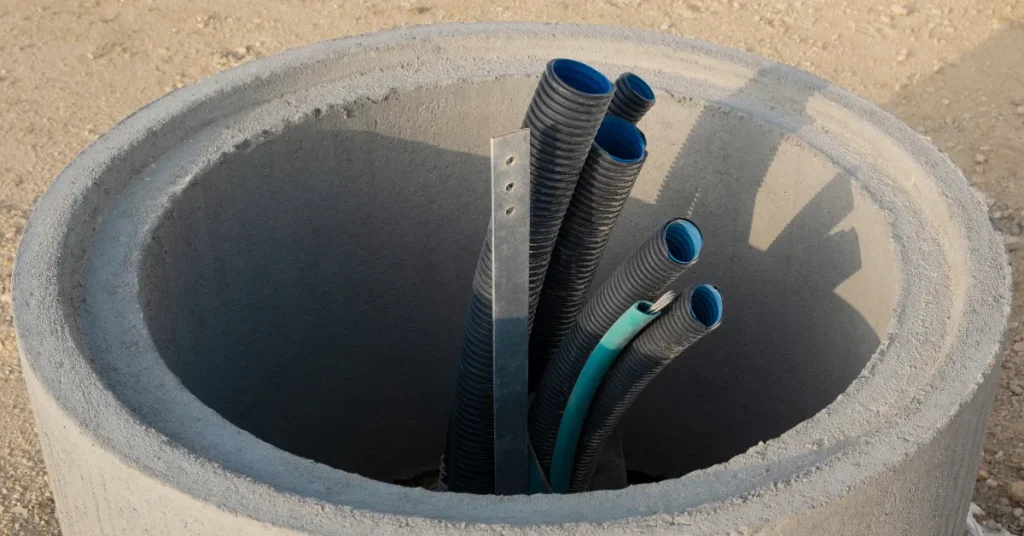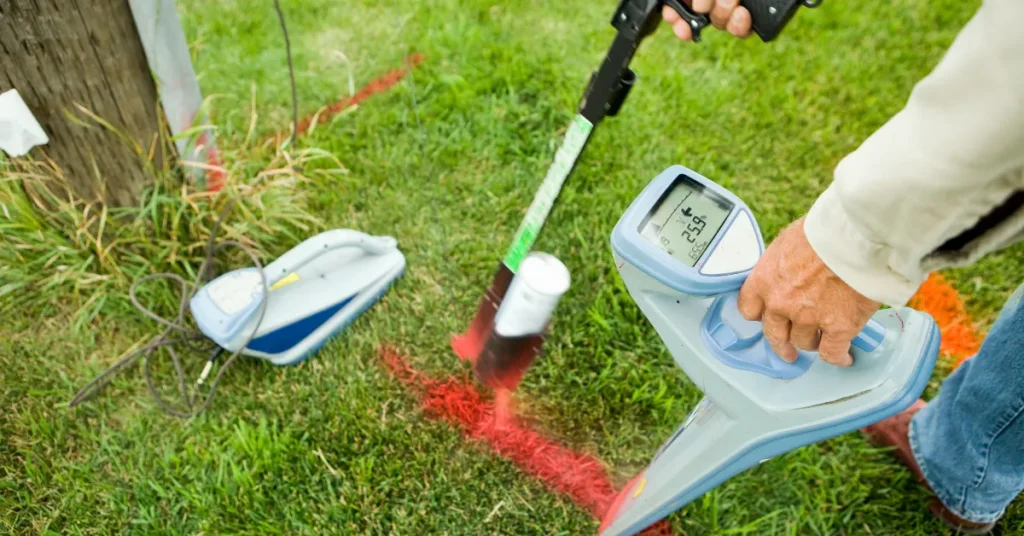Power lines are typically buried at a depth of 24 to 36 inches. Local building codes and the National Electrical Code influence this depth.
Understanding the depth at which power lines are buried is critical for safety and compliance purposes. Homeowners and contractors must be aware of this information before starting any digging projects.
The exact depth can vary depending on whether the lines are for residential or commercial use, the type of power line, and specific regulations in your area.
Ensuring that power lines are buried properly reduces the risk of power outages, accidents, and disruptions. This standard is part of essential infrastructure protocols and aids in maintaining the integrity of electrical supply networks across varied landscapes.
It’s advisable to always consult with local utilities or authorities before excavation to avoid interference with underground power lines, which can have serious consequences.

Digging Into The Depths: Power Line Installation
Power lines need safe and secure installation deep within the earth. This process keeps our streets safe and our lights on. The depth of these lines varies for protection and reliability. Let’s unearth the secrets beneath your feet and explore how deep power lines rest.
The Essentials Of Buried Power Lines
Buried power lines form a crucial part of our electrical system. These hidden conduits carry electricity from substations to our homes and businesses.
They must sit at a safe depth to avoid disturbances and hazards. Various factors such as line voltage, soil type, and location influence how deep the cables must go.
- Protection: Layers of earth shield the cables from damages.
- Insulation: Soil insulates and secures these lines.
- Regulations: Guidelines determine the minimum depth for installation.
National Standards Vs. Local Variations
The depth for power line burial isn’t a one-size-fits-all scenario. National codes such as the National Electrical Code (NEC) provide a baseline. However, local rules can adjust these depths to better suit their unique conditions.
| Type of Area | National Standards (in inches) | Local Variations (in inches) |
| Residential | 24″ | Varies by locality |
| Commercial | 36″ | May differ based on local laws |
| Rural | 30″ | Determined by local terrain and conditions |
In areas with heavy machinery or susceptible to flooding, additional depth may get mandated. It’s vital for contractors to consult with local utilities for precise requirements.
Safety First: The Importance Of Depth
Depth is key in preventing accidents and ensuring the longevity of utility services. To safeguard the community and infrastructure, power lines need burying at specific depths.
These depths vary due to several factors, including the type of line and location. Keeping power lines safely underground prevents electrical hazards and service interruptions.
Adequate depth is a barrier against accidental digging and environmental elements, forming an essential aspect of urban planning and public safety.
Protective Measures For Underground Utilities
Underground utilities require layers of protection. Concrete encasement, warning tape, and sand padding secure and alert to the presence of buried power lines. Regulatory bodies issue standards; adhering to them ensures safety.
- Concrete Encasement: Shields against damage.
- Warning Tape: Signals caution to excavators.
- Sand Padding: Provides a buffer zone around cables.
Minimizing Risks: What Lies Beneath
Understanding what lies beneath our feet minimizes the risk of accidents. Digging without knowledge can lead to severe consequences. Before excavation, it is crucial to consult Call Before You Dig
| Service | Typical Depth (Inches) |
| Electric Power Lines | 18 – 24 |
| Communication Cables | 12 – 18 |
| Gas, Water and Sewage | 12 – 30 |
Maps of utilities are available; using them prevents service disruption and accidents. Safe digging practices ensure everyone’s protection. Let’s keep safety first when it comes to what lies beneath.
The Depths Unveiled: Residential Vs. Commercial

Understanding the depth at which power lines are buried helps ensure safety and compliance with legal standards. This varies significantly between residential areas and commercial properties. Let’s dig into the specifics of each to uncover just how deep those cables need to go.
How Deep for Your Home?: Residential Guidelines
How Deep For Your Home?: Residential Guidelines
Residential power lines follow strict guidelines to protect homeowners and their families.
- Minimum depth: 18 inches
- Service conductors: Could be 24 inches deep
- Local regulations could dictate more depth
These depths are designed to avoid accidental dig-ins during routine home maintenance.
Commercial Complexities: Deeper For A Reason
Commercial properties have diverse requirements for their power lines. Greater depths ensure uninterrupted services to businesses.
| Type of Commercial Property | Typical Depth |
| Parking lots and light commercial zones | 24 inches |
| Heavy industrial areas | 36 inches+ |
| Areas with large machinery | Depths can be 48 inches or more |
These requirements reflect the higher risks and heavier usage in such environments.
Regulatory Depths: Codes And Compliance
The depth at which power lines are buried is a crucial safety consideration. Strict codes and compliance regulations exist to protect infrastructure and ensure public safety.
These regulations are detailed in national codes like the National Electrical Code (NEC), yet adapted by local jurisdictions to fit unique environmental and infrastructural needs. Understanding these rules is essential for any construction or digging project.
Navigating The Nec: Code Requirements
Adherence to the NEC is non-negotiable for electrical professionals. It sets the minimum depth for buried electrical cable, which varies based on the type of electrical lines and the presence or absence of protection like conduits or enclosures.
Here’s a quick glance at NEC’s typical depth requirements:
- Residential premises: 18 inches
- Commercial areas: 24 inches
- Lines under roads: 36 inches
This is to mitigate risks like accidental digging into lines, which could cause serious harm or service interruption.
Local Regulations: Tailoring To Terrain And Traffic
Local regulations often refine the NEC’s guidelines, considering factors unique to each area.
Different terrains, such as rocky ground or flood-prone areas, may require modifications. Similarly, high traffic zones might need deeper burial to withstand the pressure of vehicular movement.
Local utility companies and municipal regulations play a key part in determining these depths. They ensure compliance with both national standards and additional local safety measures. It’s critical to consult them before any construction or excavation work begins.
Technological Trends: Innovations In Burial Techniques
Power lines need to be buried deep for safety and reliability. New technologies are changing how we do this. They make it safer and more efficient. Let’s dive into the latest innovations in burial techniques.
Advanced Equipment For Excavation
Excavation equipment has evolved. Today’s tools dig faster and disrupt the soil less. These advancements mean power lines get buried with minimal impact on the environment.
- GPS-guided machinery enhances precision.
- Trenchless technology slides lines underground without open trenches.
Future Of Digging: Safer, Deeper, Better

Innovative approaches in digging are shaping the future. Safety is the top priority. The aim is to protect workers and the public. Technologies like remote-controlled excavation play a huge role.
- Smart sensors prevent accidents.
- Robotic drillers operate in tight spaces.
- Automated digging systems enhance safety.
Expect these trends to lead to deeper, safer burial of power lines. Future techniques could move even beyond current capabilities.
Power lines might go deeper, with less risk and disruption. This will be vital for expanding urban areas.
Grounded In Safety
The depth at which power lines are buried is crucial. It ensures the safety of communities and maintains service integrity. Through strict regulations, utility companies follow safe burial practices. This minimizes risks associated with electricity lines.
Summary Of Safe Burial Practices
Standard depths for the burial of power lines range from 18 to 24 inches. It could vary based on factors like:
- Local guidelines and codes
- The type of electrical line
- Geographical location
Utility companies use insulation and warning tape for further protection.
| Type of Power Line | Minimum Depth |
| Residential | 18 inches |
| Commercial | 24 inches |
| High-voltage Lines | 36+ inches |
Encouraging Vigilance For Future Excavations
Before digging:
- Check for utility maps
- Call 811 – the national “call before you dig” number
- Get a professional survey
This prevents accidents and ensures public safety. Contractors must also maintain updated knowledge on safety standards.
FAQs About How Deep Are Power Lines Buried
What Is The Standard Depth For Buried Power Lines?
Buried power lines typically follow regulatory depth standards, which can range from 18 inches to 24 inches for residential areas. For commercial or industrial areas, the required depth may be deeper, often up to 36 inches.
How Do Environmental Factors Influence Power Line Burial Depth?
Environmental factors, such as soil type, frost lines, and the likelihood of natural disturbances, can affect burial depth. Regions with harsher climates might necessitate deeper placement to prevent damage from freezing or erosion.
Can I Dig Near Underground Power Lines?
Digging near underground power lines is not safe without appropriate precautions. Always call 811 for the “Call Before You Dig” service to have lines marked, ensuring you avoid accidental contact with buried utilities.
Are Deeper Buried Power Lines Safer?
Deeper buried power lines have a lower risk of accidental excavation damage and can offer enhanced protection from environmental stress. However, simply being deeper does not safeguard against all types of damage or malfunctions.
Conclusion
Understanding the depth at which power lines are buried is crucial for safety and city planning. It ensures compliance with regulations and prevents disruptions.
Whether for construction projects or simple curiosity, the knowledge shared here plays a vital role in community infrastructure management.
Let’s keep our communities safe by staying informed.
Resources:
1. https://www.fema.gov/case-study/overhead-underground-it-pays-bury-power-lines
